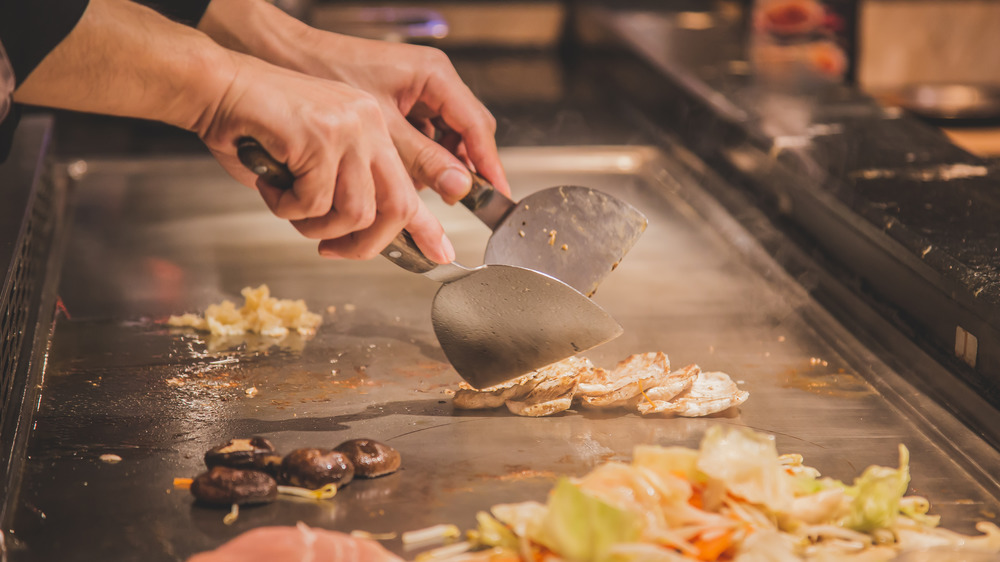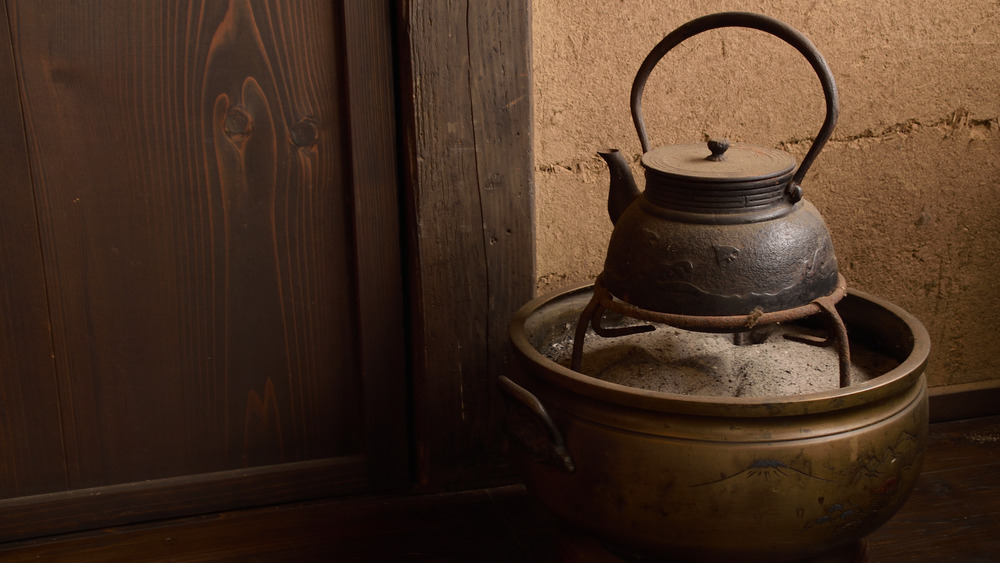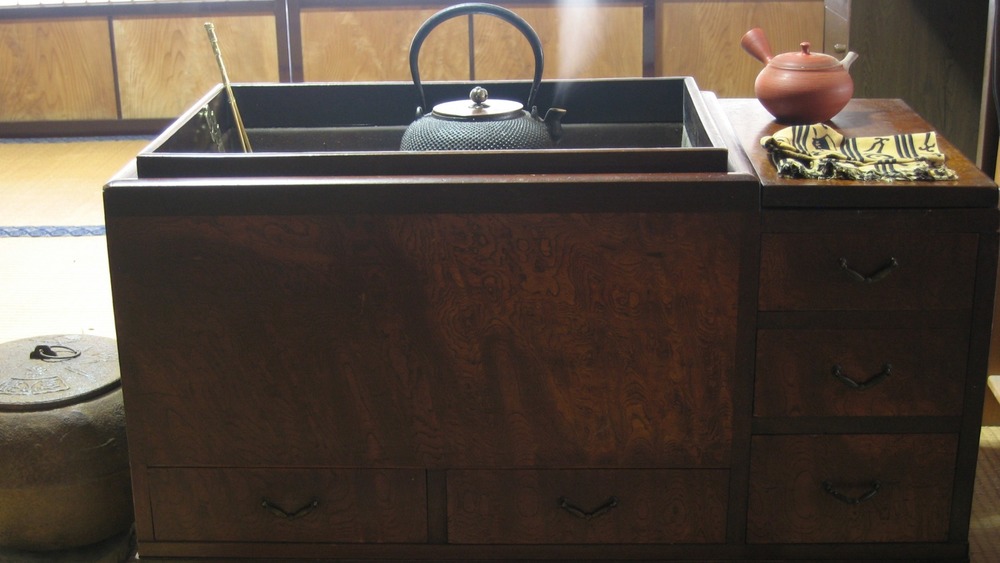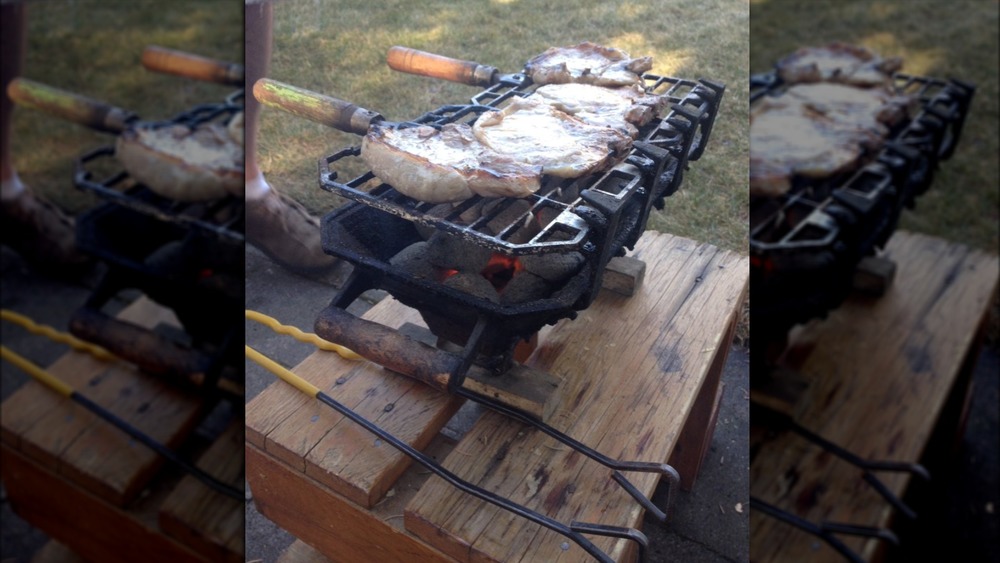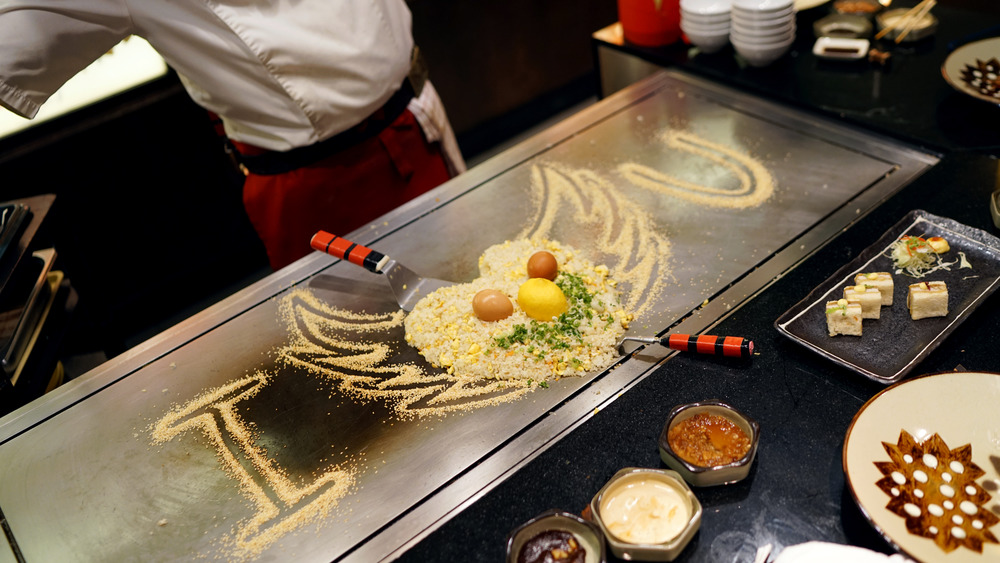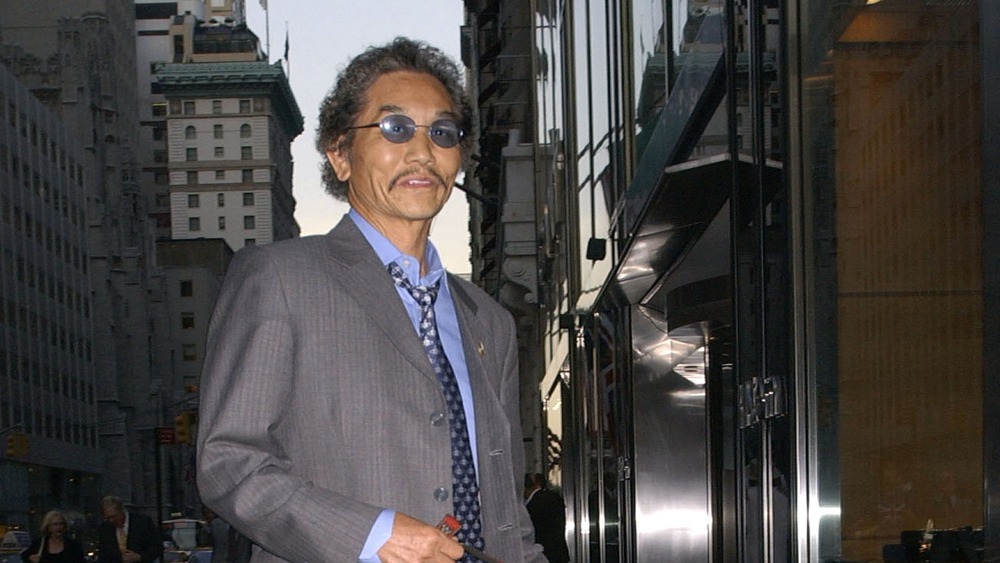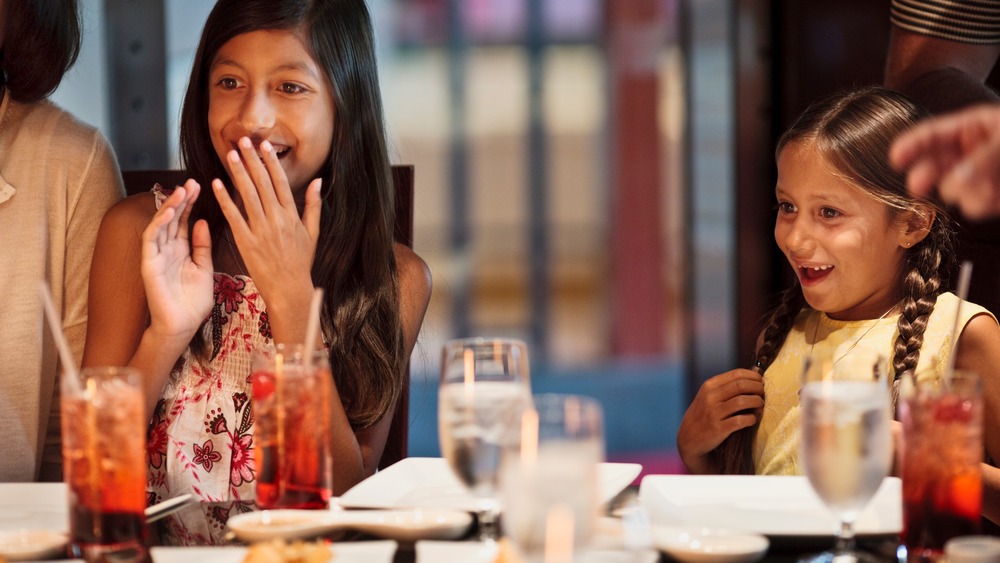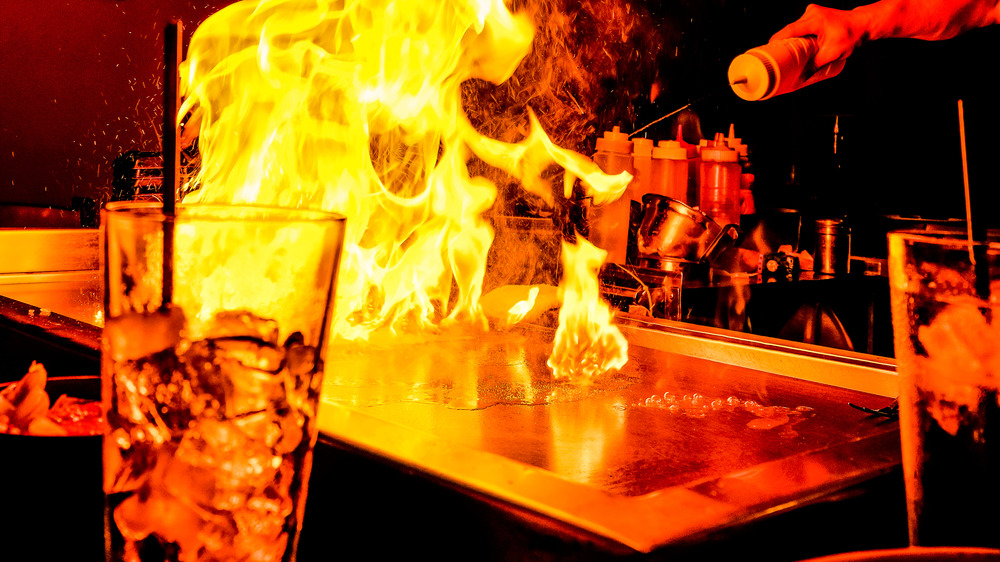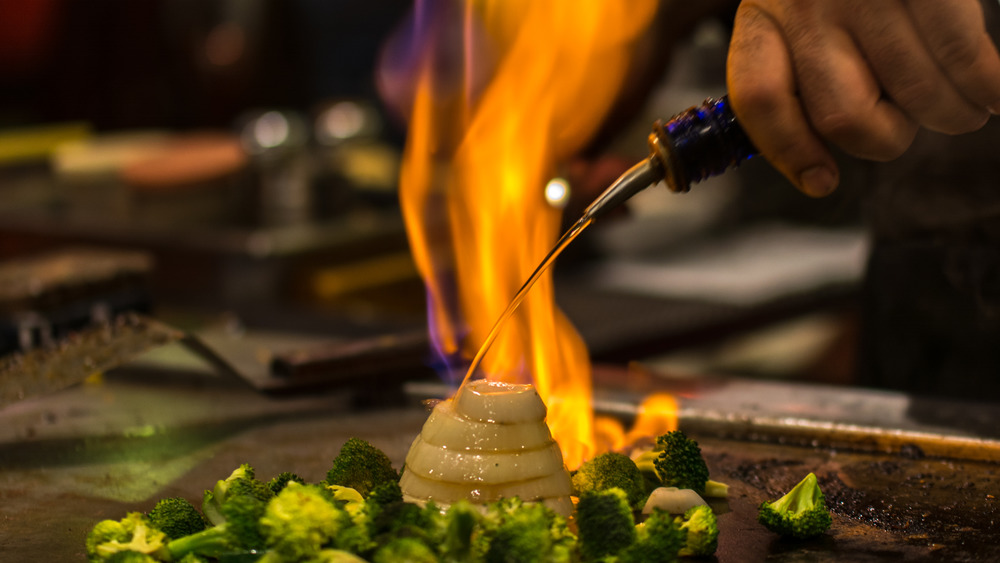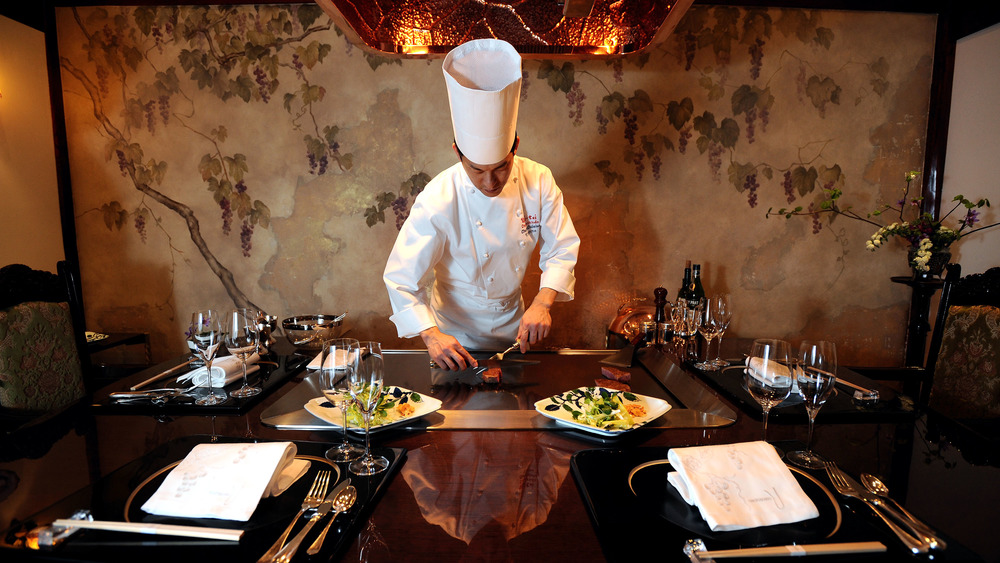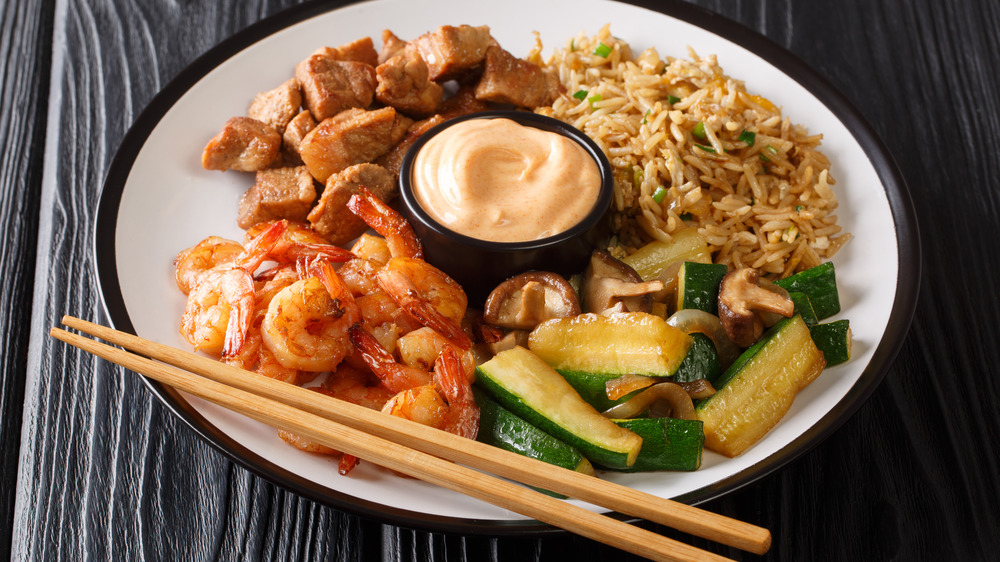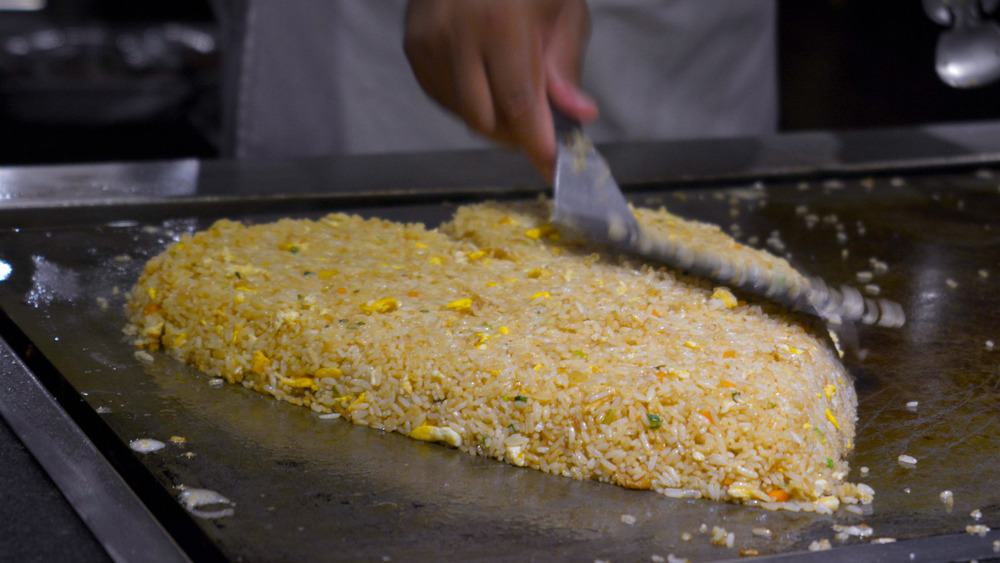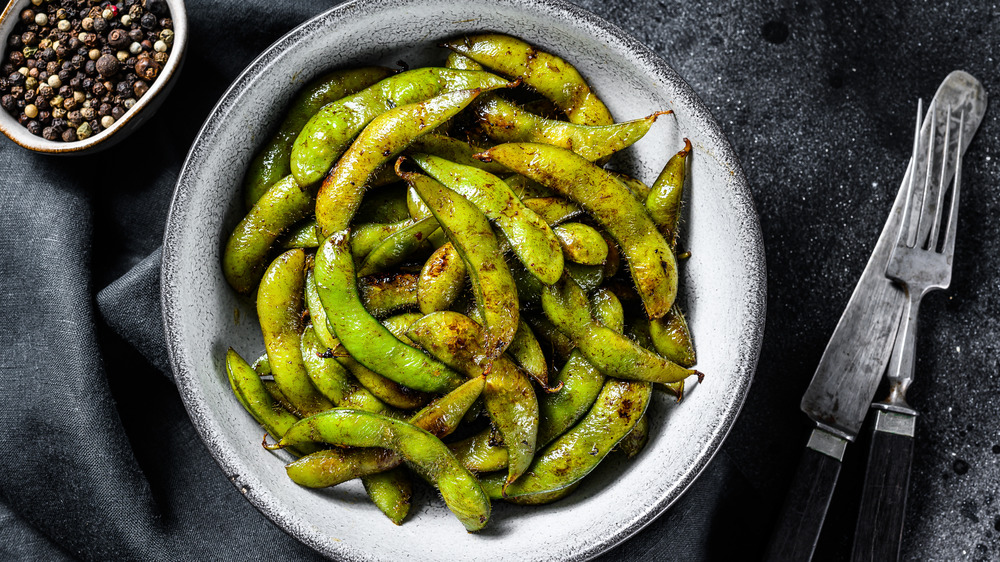Read This Before You Eat Hibachi Again
There are Asian restaurants, and then there is hibachi — a class of restaurant that's known to provide doses of thrilling culinary entertainment along with its cuisine. If you've been to a hibachi restaurant, you probably remember chefs in tall hats performing risky stunts with kitchen tools, while you most likely gorged on dollops of fried rice glistening with soy sauce.
For most of us, the word 'hibachi' is associated with performing chefs and Asian food. However, a dive into the etymology of the word along and into historical records reveals that the word 'hibachi' has come a long way from what it originally meant (via Traditional Japanese Furniture). When hibachi chain restaurant Benihana was conceptualized in the US, it laid emphasis on showmanship and an exaggeration of the exoticness of Japan as a country (via Milk Street Radio). So, hibachi, while referring to a whole world of shrimp tempuras, sashimi platter, and Japanese steak on one hand, also offers a commercialized gateway into exploring the Eastern world. But this also raises the moral dilemma of cultural appropriation and historical accuracy, the latter of which is not exactly the point of an evening at Benihana.
To learn more about where hibachi comes from, you can start with the knowledge that hibachi concept, or, as we know it today in the US, teppanyaki, is actually considered a Western style of cooking in Japan. And what 'hibachi' has meant has evolved and changed over centuries. Here's how that came to be.
The original meaning of hibachi was fire pot
If you've been to a hibachi restaurant, chances are you've witnessed a chef cooking your order on a hot metal plate grill. But the original hibachi, as the Japanese know it, looks nothing like what you see in American restaurants like Benihana.
The word hibachi, when split, translates to "hi," which means "fire," and "hachi," which means "pot." So, back in the day, a hibachi meant just that: a bowl within which orange burning charcoal was placed (via Shogun). The original hibachi served primarily as a heating source for the home, and it was also utilized for 'tetsubin,' or an iron tea kettle. At times, an iron grill for cooking was placed on the hibachi, and eventually, this practice was taken out of homes and into public dining spaces.
The hibachi itself, according to the book Traditional Japanese Furniture by Kazuko Koizumi, was made from a variety of materials, including "wood, metal, ceramic, clay and rattan," and it was available in a range of shapes and sizes. Every house had one of these pots, according to "Japanese Home Life," an 1893 essay by journalist Eliza Ruhamah Scidmore, whose detailed accounts of Japan were published in National Geographic magazine.
Since its origin during the Heian Period, also known as a golden age for Japan, the hibachi has come a long way. Hibachis now come in modern designs and with innovations that include foldable legs, different height settings, and so on.
Hibachis have had many styles, shapes, and uses
Hibachi, a word that today denotes an open iron grill, was not originally known as something to cook your steak on. Even something as basic as boiling water was not what hibachis were built for. Hibachis were actually just home heaters that served a variety of uses before becoming the cooking devices we know today.
In 19th-century journalist Eliza Ruhamah Scidmore's travelogue Jinrikisha days in Japan, the author refers to hibachis used by artists to dry painted crapes or presented to guests to warm themselves. A special type of hibachi, called palace hibachi — characterized by ornate designs on its surface — was found in palaces, and "in the homes of samurai and affluent merchants," according to Traditional Japanese Furniture by Kazuko Koizumi.
Since it was part and parcel of every home in Japan, the simple charcoal brazier regularly reinvented itself both in appearance and functionality. For example, there were sizable hibachis that were built into desks complete with drawers, and then there were mini-sized ones that could be used by two people at a time at the most. There were a great many options when it came to make as well. Some were made with Paulownia or Empress trees, whose trunks provided good insulation, while some were built with blue-and-white porcelain, and some others with the vines of a rattan tree.
Hibachis stayed relevant over centuries in Japan, eventually making their appearance in the United States by the late 1940s.
Hibachi grills became popular in post-World War II America
A lot of things happened after World War II. The American soldiers who fought in the Pacific returned home, the unemployment rate dropped, and the spending capacity of Americans shot up. What this also resulted in was a new-found desire for travel. As mentioned in the National Museum of American History website, travel to places such as Pacific Islands, Caribbean and Southeast Asia exposed Americans to new cultures. "Returning home, they re-created these experiences in their new suburban backyards, with patios, tropical drinks, and the grill, where they cooked meals craved by a postwar meat-mad America," the museum reports.
However, there was one hiccup: Suburban yards were not cut out for "giant community-sized grills used for traditional and southern barbecues". They looked for something smaller, something portable. And this demand let the Japanese hibachi make its way to the American market. "Because of its size, the hibachi was much favored by apartment dwellers that didn't have big outdoor spaces for the larger grills," according to the National Museum of American History.
While hibachis that are traditionally designed for smaller pieces of meat, the Hibachi Company of Taiwan created a double-grill version that was specially manufactured to accommodate Americans' interest in cooking large pieces of steak.
Hibachi is not the same as teppanyaki
When you go to a hibachi restaurant, what you are treating yourself to is in fact teppanyaki. "Teppanyaki is seen by some as an outgrowth of the family-style hibachi ("fire bowl") grill, which has been around for hundreds of years, but the two are quite different," reports Japan Today. However, over the years they have grown to mean the same. Hibachi, as we have established, is an open charcoal grill. Teppanyaki, on the other hand, uses a solid covered metal surface over the iron griddle, and uses propane gas as the heat source.
More importantly, the concept of chefs cooking right before you while also skillfully performing antics, such as at a hibachi restaurant, has to be credited to teppanyaki, a style of cooking that was born in the Sannomiya downtown district of Kobe in Japan after World War II.
The war had just ended, and the place was crowded with American soldiers. These soldiers were quite displeased with the food they got from the restaurants in Japan. Shigeji Fujioka, owner of a restaurant named Misono, caught scent of the dissatisfaction and replaced the traditional Japanese okonomiyaki, or wheat flour pancake, with beef steak to attract the Americans. The restaurant also transformed as a place where customers came to be entertained. "The occupation era photos that are on display in Misono show Japanese dancers seated along with the Americans, all in search of something exciting and extravagant," reports Japan Today.
Hibachi in the US was popularized by an Olympic wrestler
The relationship between America and Japan wasn't always cordial, and Japanese Americans faced a sizeable chunk of the animosity. During World War II around 140,000 Japanese Americans were put in concentration camps on US soil, reports Milk Street Radio. According to professor Ji-Song (Robert) Ku, who teaches Asian and Asian American Studies at Binghamton University, Japanese people were also subjected to "racist caricaturing" during the war. This attitude took a 360- degree turn during the Cold War, as the Japanese gained a reputation as "good" Asians while America directed its focus toward other Asian countries that supported communism, such as China and North Korea.
So, by the time Rocky Aoki, a wrestler who came to America from Japan in 1959, opened up Benihana in 1964, Japan was in America's good graces. Moreover, in the 1960s, "Japan becomes a playground for Americans with some means to go and visit." (via Milk Street Radio) This exposed Americans to the culture of geishas and samurais and built a certain fascination with Japan. Aoki could sense this fascination, and he built the interior of Benihana with Japanese woo and other Japanese decorations. He then adopted the teppanyaki style of cooking that had already become popular among American soldiers in Kobe, Japan.
"We cook everything right on the table, right in front of customers' eyes. I think in today's restaurants we have to have showmanship," Aoki said. And thus was born hibachi as we know today.
You might have to share your table with strangers while hibachi dining
If we were to go by the essay "Japanese Home Life" by W. Delano Eastlake, hibachi was an appliance around which children huddled while listening to a story or young women sat while doing their needle work. However, Eastlake's account of everyday life in Japan is from the late 1800s. While the warmth from the heated charcoal in a hibachi brought family members to sit around it back in the day, today, in a hibachi restaurant, the chef brings a bunch of diners together around a single 700 degree hot grill.
"The dining room consists of a series of back‐to-back hibachi tables, each a large rectangular cooktop framed by a wooden dining ledge that seats eight. If your party numbers fewer than eight, you have no choice in your dining companions," reported The New York Times of the popular hibachi restaurant Benihana's interiors in 1979.
That decades-old description fits almost any hibachi place. Besides sharing your table with strangers, you ought to also place your order along with them, advise the brains behind Kobe, a Melbourne, Australia-based teppanyaki restaurant. This is important, as the chef, who often comes along with a cart carrying "salt, pepper, butter, soy sauce and sesame seeds," would be cooking for the entire table in one shot, advises a teppanyaki/hibachi chef on Reddit.
Today's hibachi is not just about the food
A hibachi restaurant is not where you go for some quiet — it is a place that you go fully knowing that you will be spoken to, made eye contact with, and possibly even professed love to. The chefs, besides cooking your food, will also play with it. For instance, if you order eggs, chances are that the eggs will be spun on the grill and balanced on spatulas and tossed on the chefs' elbows. Some chefs even crack the egg open and manage to toss the yolk like a small rubber ball.
The whole dining experience is a theatrical episode by the end of which the chef, most times, manages to break the ice with their customers. It is not surprising to see patrons who might be tight-lipped to begin with later attempting to catch shrimp flung into their mouths by the chef. '"he flying shrimp" act, according to the head chef of the Benihana in Nassau County, was inspired from Jackie Chan's similar stunt in the 1998 movie Mr Nice Guy. Though popular with customers, it brought a $10 million lawsuit against the restaurant for allegedly being responsible for a 47-year-old man's death. (via New York Post)
One of the safer tricks is, however, the "heart-shaped rice," which "involves sculpting a fearsome amount of white rice into a perfect heart as it fries" (via Post and Courier). Some chefs go a step beyond and make it beat as well.
You are likely to see an onion volcano, among other tricks, at a hibachi restaurant
The most popular among the tricks performed by a hibachi chef is probably 'flaming onion' or 'onion volcano'. The onions are cut into slices about one-fourth of an inch wide and placed in descending order from the base to the top to form a tower. Inside this tower, which looks like Mount Fuji, a little bit of oil and a little bit of alcohol — vodka or sake — is poured, making it ready to flame up at the slightest proximity of fire.
Once aflame, some chefs take it a step further and shake some pepper on to the flame to produce sparks (via Post and Courier). While in theory it seems like a fairly simple thing to do, just getting that tower to remain standing could be quite a task. And given that the act involves fire, and can result in accidents, it is better not to be inspired to try it at home.
An extension of the onion volcano trick is the 'onion train,' where the flame is doused by a clap of the spatula on the mouth of the onion tower. Now, instead of flame, there is a gush of smoke. The tower, while still emitting this smoke, is moved around to look like a steam engine train of yesteryear.
Hibachi chefs undergo extensive training, including for their style
Becoming a full-fledged hibachi chef requires more than just a crash course like the one Benihaha once offered its customers through their "Be the chef" program. Chefs who are serious about wielding their spatulas and two-tine forks with confidence spend around six months working four days a week to get there. And the journey is quite arduous, according to a hibachi chef's confession to Delaware Online.
The training period can vary depending on the restaurant. For example, with Benihana, the trainee chefs have to commit eight hours of their time five days a week until they master the skills (via Popsugar). While learning how to do the egg, shrimp and spatula tricks is part of the training, an experienced hibachi chef on Reddit notes that what is more requisite to being a great chef is to build a unique style. He says, "This is because hibachi cooking is an interpersonal activity between oneself and the table. Thus, it naturally lends to frequent customers finding a favorite chef and requesting him during future visits."
To cater to the expectations of customers, some chefs tend to use fake Asian accents. It is unfortunate, but true. Milk Street Radio reports that sometimes hibachi chefs are pressured by their bosses to do so. Why? Because "the chefs who hammed up their accents and cracked Asian jokes made bigger tips."
Every hibachi place will have a bottle of yum yum sauce
A Japanese steak is incomplete without a generous dip of yum yum sauce, which is why most hibachi restaurants have one on the table, sometimes next to a ginger sauce bottle. "Ginger for fish, yum-yum for beef and chicken," as a Benihana chef put it (via Business Insider). The story of this mysterious tangy and sweet pink sauce, which looks a hybrid between mayo and ketchup, surprisingly, doesn't begin in Japan, where the teppanyaki style was born. Yum yum sauce is as American as it can get.
Japanese cuisine experts attest to the fact that the Japanese aren't used to the idea of having steaks with yum yum sauce. And yet, it has earned a permanent spot in Japanese steakhouses in America. "Almost every teppanyaki restaurant will serve it, though its name differs depending on whom you talk to. White sauce (a deceptive moniker), shrimp sauce, yummy sauce, yum yum sauce — are all used interchangeably," reports NPR.
It had succeeded in keeping its intrigue till early 2000s, when a certain gentleman, Chuck Cutler, managed to find the ingredients and began selling bottles of it online as 'Chuck's Easy Recipe'. Later, a teppanyaki restaurant owner Terry Ho made his own version 'Terry Ho's Yum Yum Sauce' that eventually sold in 30,000 grocery stores across the US, according to NPR.
White rice is an important part of the hibachi meal
On a daily basis, Japanese meals are crafted adhering to the principles of ichiju sansai or "one soup and three dishes," as mentioned in Mastering the Art of Japanese Home Cooking. The three dishes will include "some form of rice, protein and vegetable," writes author Masaharu Morimoto. And the rice that you include in your meal could be in a variety of forms — as a plain bowl of steamed rice, as rice balls called onigiri, rice cakes called mochi, or rice crackers known as senbei. Rice is also fermented to create sake, used in sushi, and of course, as a staple in every hibachi restaurant in the form of the classic fried rice.
According to a hibachi chef on Reddit, the best way to make hibachi fried rice is to use Nishiki, a brand of short grain rice, and cook it the day before you intend to make your fried rice. Cold rice separates out nicely on the hot grill, whereas freshly-cooked rice can easily turn mushy. The process of cooking as such is easy. Cook the vegetables/meat on the grill and set aside, then follow it with the cold rice (mixed with soy sauce), and then the egg. The final step is to add in the seasoning, which is generally just pepper and salt. Sometimes, sesame oil and garlic powder and garlic powder are added. Most chefs also like to add a generous amount of butter in their rice.
Edamame and shrimp are a constant amid hibachi appetizers
While a typical hibachi meal, with its heavily buttered fried and steak, can be a tad high on calories, the edamame bean that is part of almost every hibachi restaurant menu is, in contrast, a healthy option. Loaded with protein, iron and calcium and low on calories, the young soybean has been a popular snack in Japanese pubs, and over the years has found a place in the West as well. Some restaurants serve it boiled and mildly salted, while some others season it with togarashi, a Japanese condiment that contains a mix of sesame, paprika, seaweed and ginger among others.
Besides edamame, another ingredient that holds a top spot in Japanese cuisine is shrimp, or ebi, as they call it in Japanese. While most hibachi restaurants have a shrimp dumpling appetizer on their menu, some also offer it grilled with lemon or deep fried. While shrimp adds flavor to a hibachi meal, it also does to a hibachi chef's performance. Tossing bites of shrimp into a patron's mouth and flipping shrimp tails into the chef's own hat are some of the classic tricks that have come to be expected by anyone who walks into a hibachi restaurant.
